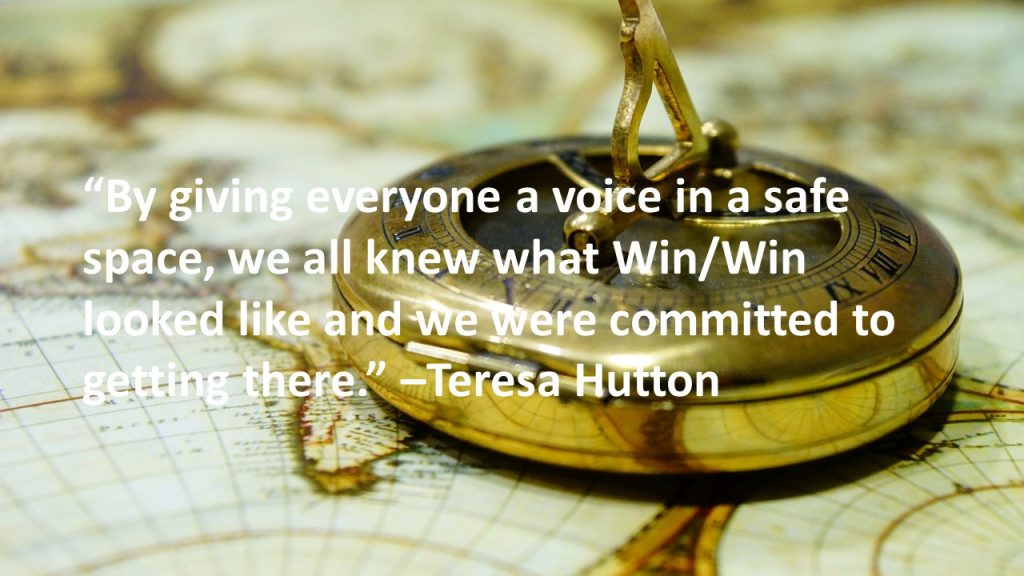Gamestorming is an approach to getting to Win/Win that engages team members and provides an environment where everyone feels comfortable sharing their ideas. We looked at the basics of gamestorming in the last post, and this week we’ll look at a real-world example.
The Pre-Mortem
As a project manager I was involved with a new product idea that was to serve an industry segment my organization was not in yet. We worked with a team from another company where the new product would be used. The new product leveraged the engineering expertise my company already had but in a new way.
In our first face-to-face meeting we needed to hammer out exactly what our plan was for getting to ‘done’. We decided to approach the research and development in phases, which is typical. We put checks at the end of each phase, and we couldn’t pass to the next phase until we met all the commitments.
We wanted to make sure we had the high-level risks identified, so I facilitated a game called ‘Pre-Mortem’. You may have heard of doing a post-mortem (we like to call them retrospectives these days) at the end of a project. This is where you look back on a project or phase and ask what went well, what could have gone better, and what you might do differently in the future. In a Pre-Mortem you find out what can go well and what can go wrong before the project starts. Here’s how we did it.
The setup: First, I armed everyone with plenty of Post-It notes and Sharpie markers. I also had an easel of giant white Post-It paper at the ready. I set the scene by asking everyone to consider how they are feeling right now.
We’re optimistic and excited about this project and the potential for a new application that will benefit both of our organizations. Now, in your mind’s eye, put yourself one year in the future. Unfortunately, the situation is not great. In fact, the project is on the brink of failure. Nothing is going the way we said it would go.
Next: Thinking back over the last year, what went wrong? Write one idea per Post-It note. Go.
The teams wrote down their ideas of how the project failed. Somehow when you ask people to imagine themselves in the future and to look back on what went wrong you get different answers than asking people to imagine what could go wrong in the future. I don’t know why, but I’ve found it to be true. Also, unfortunately, lots of people have been on less-than-stellar projects and we had a lot of ideas to work with in this pre-mortem example.
Next: I asked everyone to post their ideas on the giant white Post-It paper on the easel. Then I asked for a couple of volunteers to help put like ideas together (the Affinity Mapping game). This is great because it gets people moving, and the volunteers are actively engaged.
The results: you might expect some of the reasons for failures (which are really risks) were poor communication and the technology or design doesn’t work. But one result astounded me. The risk was: our organization is no longer interested. Wow! I don’t know that anyone in that room would have voiced that as a concern, but certainly more than one person was thinking it.
The actions: We committed to regular conference call status updates, where we would share how the research and development was proceeding. And, at the end of each phase gate we asked if our organizations were still committed. We could ask this because we came together in a safe space and agreed it was important to ask. Imagine asking if we hadn’t agreed ahead of time that it was an important question. My guess is the intent of the question would be taken out of context and/or we wouldn’t be quite honest about the outlook of our organizations. We built trust through gamestorming.
The final result: We made it past a few phase gates, but at one checkpoint one of our companies reorganized and the project was no longer important to them. So we terminated the project at that point.
Win/Win
Even though the product idea didn’t succeed, this exercise was Win/Win on many levels. One level was that the gamestorming gave us an environment where we wanted to work to find the best solution. In this case it was finding important risks that could trip up the project if not addressed. Because we identified a risk that we may not have voiced without the game, we were able to recognize the point at which the project was no longer viable and, therefore, we wouldn’t waste additional money on it. On another level, by giving everyone a voice in a safe space, we all knew what Win/Win looked like and we were committed to getting there, if possible.
tl;dr
Using a gamestorming game called Pre-Mortem, two organizations identified a risk that might not have been identified at a joint project kickoff meeting – the risk that at some point the project would be deprioritized. By giving everyone a safe space to engage and contribute ideas, everyone understood what Win/Win looked like. And, because the risk hit, we were able to pull the plug on the work before spending more money on it (which would have been wasted).
engineer your life
Although risk identification may sound like a project management activity, it can be really powerful to think through as an engineer as well. Give it a try either on your own or with your team!
Pre-Mortem reference
